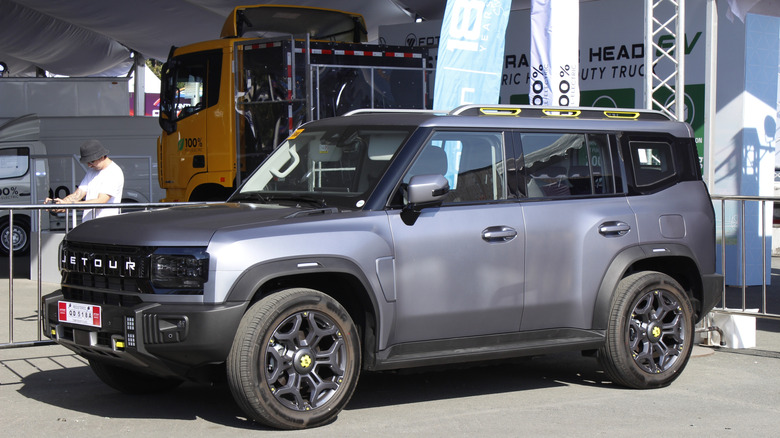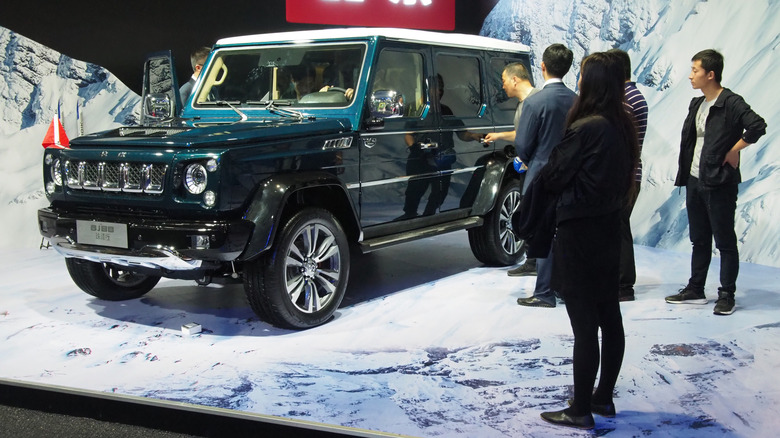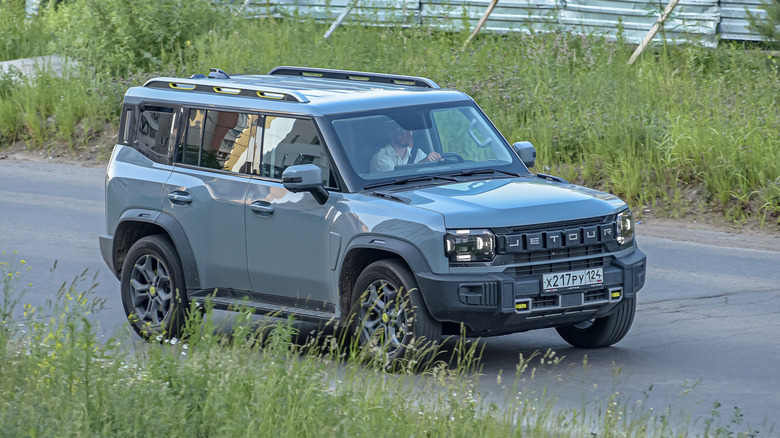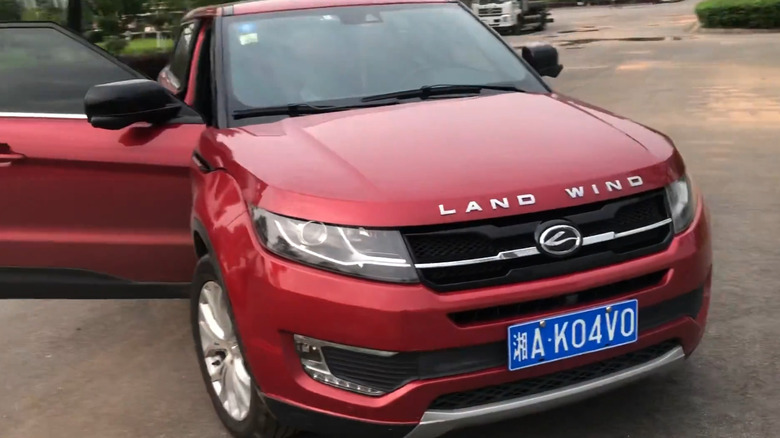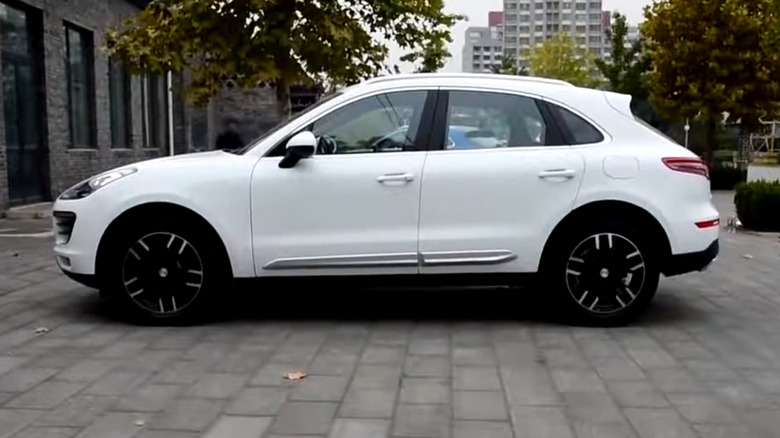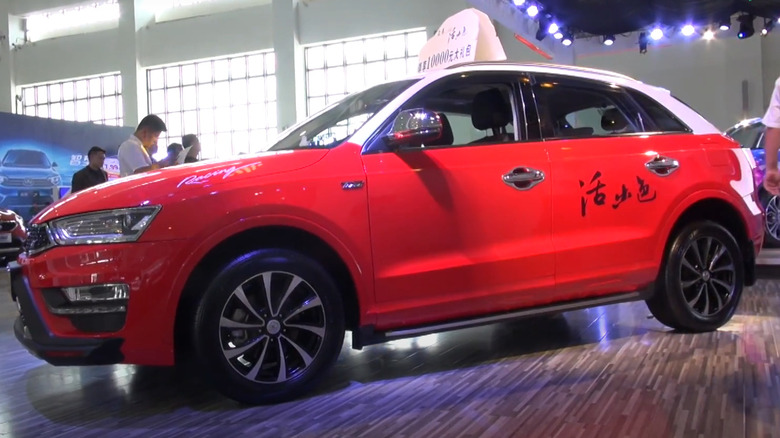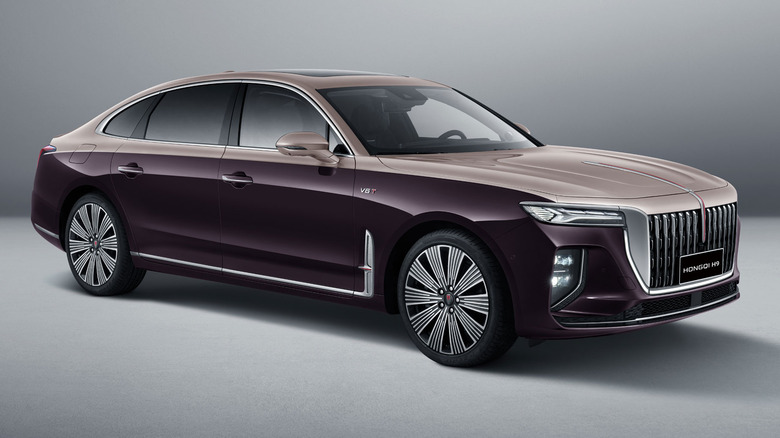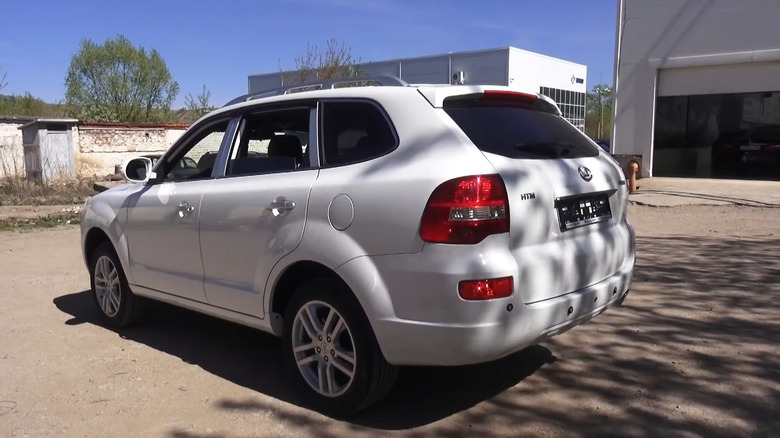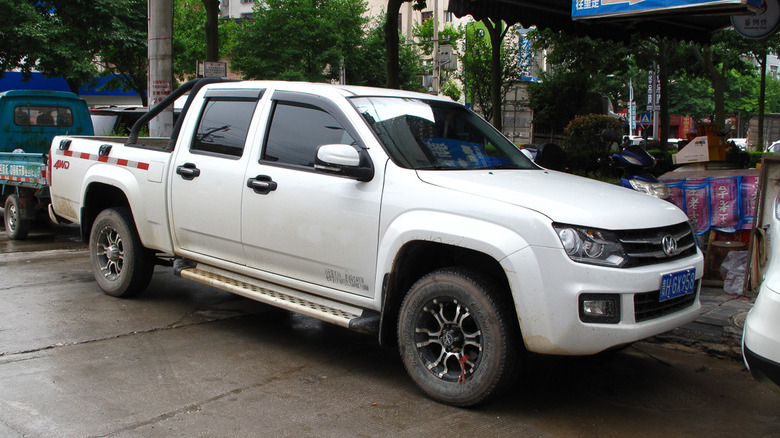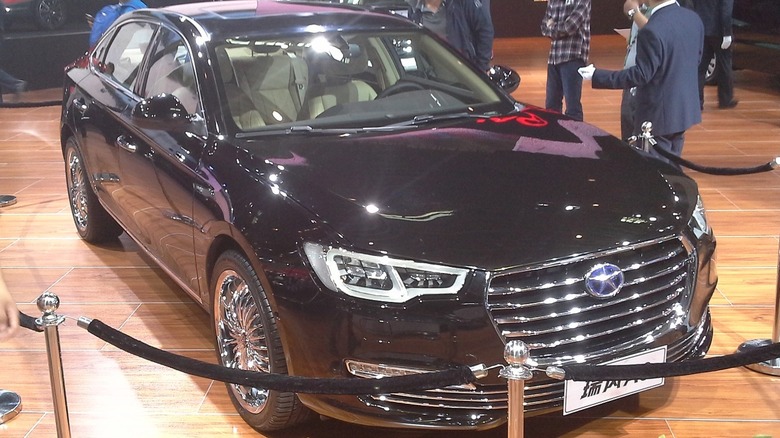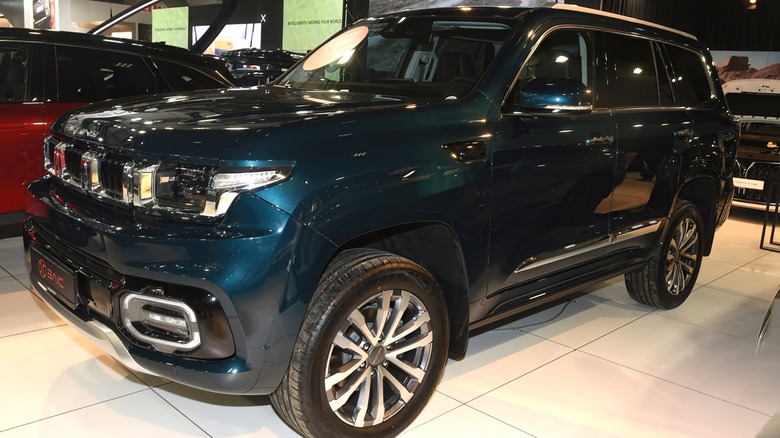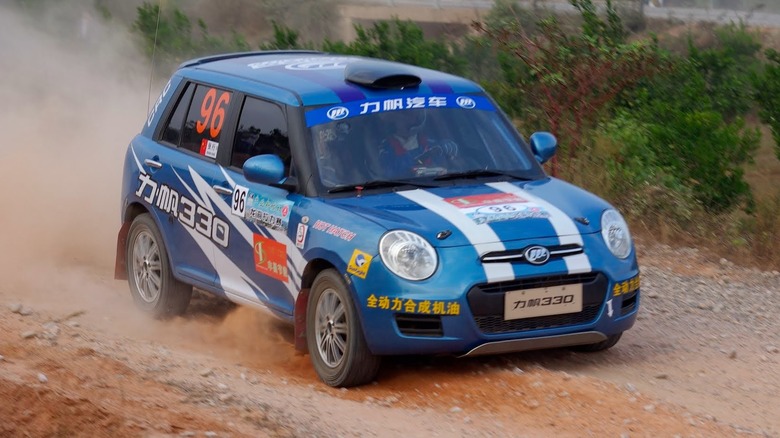10 Chinese Cars That Are Cheaper Than Their Closest Counterpart
If there's one auto industry on the planet that has mastered the precise art of giving buyers premium looks at budget prices, it's China. The path they use to get there is somewhat questionable, though. You see, one of the biggest costs when developing a new vehicle will undoubtedly be research, development, and design. So, while Western automakers spend millions — sometimes billions — developing a new car, Chinese carmakers have taken a decidedly different approach. They identify what works, they study it very closely, and then they produce something remarkably similar at a fraction of the cost. In other words, they copy other brands' designs to the point where lawsuits are filed (and won) by the Western manufacturers... but more on that later.
If it works, it works, and admittedly, China does make some pretty cool cars. The Chinese "counterparts", so to speak, deliver about 70 to 80% of that premium/luxury experience at around 30 to 40% of the cost, sometimes less. And China's imitations aren't just limited to cars either. They've copied a lot of Western stuff, such as mobile apps and social networks, and even Lockheed Martin's F-35 fighter jet. With all that said, here are 12 Chinese cars that are cheaper than the vehicles that inspired them.
$46,300 BAIC BJ80 ($148,250 Mercedes G-Class)
Not everyone can afford a Mercedes G-Class, but many appreciate its design and would welcome a more affordable version. And that is exactly what the BAIC BJ80 delivers, with many brands calling it a straight-up clone of the G-wagon. Pricing for the BJ80 starts at 298,000 Yuan, which converts to $41,660 at the time of writing, which is consistent with the online listing by exporters. The cheapest new G-class, by contrast, is the 2025 G-550, which has a base MSRP of $148,250. The similarities between the two vehicles are uncanny: both have the flared, angular wheel arches, exposed hinges on all doors, the boxy shape, and even the round LED headlights at the front.
The engine on the BAIC BJ80 is a 3.0-liter twin-turbo V6 that makes a modest 280 hp and 310lb-ft of torque – a far cry from the 443 hp and 413 lb-ft made by the 3.0-liter inline-six unit on the Merc. Creature comforts inside the BJ80 are numerous and include an 8-inch touchscreen infotainment screen, full panoramic sunroof, ambient lighting, automatic, auto-leveling Xenon headlamps, powered front seats, and lots more as standard. Additionally, not content with imitating the Mercedes 4x4, BAIC even released a 6x6 version of the BJ80, which, of course, looked strikingly similar to the Mercedes 6x6. Furthermore, in 2019, BAIC went so far as to release a 70th anniversary model in red supposedly to commemorate the anniversary of the PRC's (People's Republic of China) founding.
$25,000 Jetour T2 ($58,750 Land Rover Defender)
Founded in 2018, Jetour is one of the youngest car brands in the world. One look at the Traveler T2 is all it takes to understand that the inspiration for this car is the Land Rover Defender – a boxy, comfortable SUV that can seat up to seven passengers. On the Jetour, five seats are standard, though a T2 extended model is available that offers seating for up to seven. Engine options are a 1.5-liter four-cylinder unit that makes 181 hp and 214 lb-ft of torque, and a larger, more powerful 2.0-liter four-cylinder engine that produces 251 hp and 288 lb-ft of torque.
A 15.6-inch infotainment display comes standard, along with a 540-degree panoramic parking system, adaptive cruise control, lane keep assist, and much more. However, there are some marked differences between the two. For instance, the front fascia on the Jetour is very different from the Defender, the T2 won't be as good off-road, and of course, there's the price. A 2024 Jetour T2 currently retails for about 179,900 Yuan, which equates to $25,150 at the time of writing. Compare that to the cheapest four-door Defender on the market, which costs $58,750, and the value proposition is clear. Who knows, we may one day see these things crawling through suburban America, but it remains one of many cars that we can't buy in the U.S., for now.
$20,000 Landwind X7 ($41,475 Range Rover Evoque)
Back in August 2015, a Chinese automaker called Land Wind took their homework-copying a bit too far when they released the Land Wind X7. It was so blatantly a copy of the Range Rover Evoque that Jaguar-Land Rover actually filed a suit against Land Wind on several counts of design theft and plagiarism. Both cars were five-seater, five-door models; both had a slanting roof, both had a chiseled hood, and the original 2015 X7 also copied the headlight design from the Rangie. Even the front wheel arches "ate" into the hood like they did on the Evoque.
The JLR group eventually won the lawsuit, which is probably why the Land Wind X7 hasn't been in production since 2019. The 2015 model came with a 2.0-liter turbocharged engine that produced 188 hp and 184 lb-ft of torque, paired to either an eight-speed automatic or a six-speed manual gearbox. The X7 received a facelift around 2018, but even that was strikingly similar to the Evoque. Pricing for the X7 began at 128,900 Yuan, which, back at the time, translated to about $20,000. On the other hand, a 2016 Range Rover Evoque came with a base MSRP of $41,475 – more than double the price.
$27,400 Zotye T700 ($52,600 Porsche Macan)
In 2016, Chinese brand Zotye launched two vehicles, both of which were clearly inspired by an SUV in the VW group lineup. The first was the Zotye T700, called the SR9 in some markets. It is a clone of the Porsche Macan, and the most blatant case of plagiarism on our list so far. Other than the Peugeot-styled headlamps, the Zotye was practically a copy-and-paste version of the Macan, but with a 2.0-liter four-cylinder engine from Mitsubishi that made 190 hp and 184 lb-ft of torque. The front looked like the Macan, the sides looked like a Macan, and the uninitiated would be forgiven for mistaking the rear for a Macan. Though Zotye did facelift the car in 2019, the damage was already done, and Zotye eventually went bankrupt.
In terms of pricing, the T700/ SR9 came in with a launch price of 170,000 Yuan, which was about $27,400 at the time. Equivalent entry-level versions of the Porsche Macan were retailing for a base MSRP of $52,600. Also, in 2017, Zotye launched a "woman only" version of the T700/ SR9 called the "Goddess Edition" (literal translation), which was pink. All that said, cars like the T700 do make you think — if these can be provided for a fifth of the price of the original and at a similar quality, is it really worth paying that much just for the badge on the steering wheel?
$15,900 Zotye SR7 ($32,500 Audi Q3)
The next offence also comes from Zotye, though this 2015 model copied not the Macan, but the Audi Q3. During the pre-release period, it was referred to as the Zotye S21, but at launch, it was renamed SR7. The front of the car looks like a Golf, Polo, Jetta, or Passat, but from the side, it's an Audi Q3 through and through. The Zotye's infotainment screen appears original until you learn it was "inspired" by the Volvo XC90's tech. Still, it, alongside the 360-degree parking system, is a nice-to-have feature at this price point.
The power unit on the SR7/S21 is a 1.5-liter four-cylinder petrol that produces 150 hp and 146 lb-ft of torque. This engine was paired to either a continuously variable transmission or a five-speed manual, depending on the spec. Pricing for the SR7 began from 100,000 Yuan, or $15,920 at the time, whereas the Audi Q3 came with an MSRP of $32,500. According to the brand, the SR in the name is an acronym for "sixth revolution", and 7 is simply the next in the series. Additionally, this isn't the only VW Group car that Zotye has, erm, imitated – they also make a clone of the Tiguan, called the Damai X5, and the T600, which copies the Audi Q5.
$42,440 Hongqi H9 ($336,000 Rolls-Royce Wraith)
While all the cars we've covered thus far have gone for luxury and luxury-adjacent brands, a Chinese company named Hongqi (pronounced Hong-Chi) decided to go for the king of the hill. They copied the Rolls-Royce Wraith, and this is one we're not exactly mad about. For while a new Wraith would run buyers a cool $366,000 in 2025 – and that's before the vast customization bill — the Hongqi H9 comes in at 259,800 yuan for the 2023 model, or $36,315 at current exchange rates. What's more, the H9 has all the bells and whistles that the Wraith has, such as adaptive cruise control, fully automatic parking, a heads-up display, an armrest touchscreen for rear passengers, Bose audio, and a 12.3-inch touchscreen.
Furthermore, standard driver aid features on the H9 include auto-emergency braking, blind spot detection, lane departure warnings, and a collision avoidance system. The engine is a 2.0-liter turbocharged four-cylinder unit with 252 hp and 280 lb-ft of torque, and mated to a seven-speed dual-clutch automatic transmission. There is also the option to upgrade to a 3.0-liter V6 engine that produces 281 hp and 295 lb-ft of torque. Stylistically, it's easy to see the similarities, with the acres of bonnet, the stand-up emblem above the grille, the sloping roof at the back, and the disproportionately short rear boot lid. However, it's literally one-tenth of the price, so a lot can be forgiven.
$10,930 Yema T70 ($44,705 Volkswagen Touareg)
VW Group has been getting the short end of the stick with Chinese counterfeiters. In 2019, Chinese automaker Yema released an SUV called the T70 that looked like an off-brand version of the VW Touareg — and the similarities were uncanny. Yema T70 also drew inspiration from Land Rover, with its front fascia, and Jeep, with the taillights from the Grand Cherokee.
There were two engines available on the T70, with the base variant being a four-cylinder producing 131 hp and 125 lb-ft of torque, displacing 1.8 liters. The second option is a tuned version of the same 1.8-liter unit with 171 hp and 159 lb-ft of torque. Pricing for this more affordable version of the Touareg began at 79,800 Yuan when it was launched in 2015, which translated to $10,930 at the time. Compared to the actual Volkswagen Touareg that retailed for $44,705, that's a positive bargain.
$29,540 Hawtai B35 ($45,000 Porsche Cayenne)
This next one was one of the first to copy a VW Group vehicle, though the timing was pretty curious. In 2010, a Chinese automaker named Hawtai previewed a vehicle they were going to release, called the B35. It quickly became evident that the B35 was an "homage" to the Porsche Cayenne. However, it didn't mimic the new, better-looking 958.1 Porsche Cayenne. This Chinese copycat vehicle was based on the previous 957-generation Cayenne, which, though capable, was plain ugly. Whether this is because Hawtai didn't know that Porsche AG was going to update the Cayenne, or that they didn't particularly care, remains a mystery. The fact was that Hawtai released a Cayenne imitator just as the new model launched, which potentially killed the desirability of the B35.
For one thing, though the older Cayenne was ugly as sin, it was a beast off-road. It had multiple stops on the differential, particularly impressive ground clearance for a midsize SUV, good visibility on all sides, great angles of approach and departure, and, of course, all that luxury. The Hawtai, by comparison, was severely underpowered, making 160 hp and 159 lb-ft of torque from a 1.8-liter four-cylinder motor, while weighing 3,406 pounds. The only conceivable place where it beat the Porsche was on price, with the B35 costing 200,000 Yuan ($29,540 for the time) and the equivalent 957 Cayenne coming in with a base MSRP of $45,000.
$9,840 USD Jiangling T7 ($28,948 VW Amarok)
While we may find it funny, VW executives were probably not very enamored by the Jiangling T7 that launched in 2015. It copied the VW Amarok pickup, or ute, as they are called down under, and actually achieved decent success with pickup trucks in general over the years. Additionally, readers may be interested to know that, at the time of writing, one of the major shareholders in Jiangling is the Ford Motor Company, with a 32.5% stake in the conglomerate, alongside the JMC Group (30%) and assorted public investors who hold 37.5% of the business.
The T7 has two main engine choices, with the first being an Isuzu-made, 2.8-liter inline-six producing 99 hp and 210 lb-ft of torque. The second option is a 2.2-liter four-pot unit that manages to output 103 hp and 133 lb-ft of torque. Both powerplants were paired to a five-speed manual transmission. Pricing for the Jiangling T7 came in at $9,840 in 2015 money (71,800 Yuan), while the Amarok had a base MSRP of $38,490 Australian or $28,948 U.S., although the Amarok has never been sold in America.
$19,500 JAC RA60 (Audi A6 $55,895)
Much to the chagrin of the VW Group was the JAC Refine A60 — this time, they even copied the name. It was released in 2016, shipped in 2017, and this time, it was the Audi A6 that was the subject of imitation. In terms of looks, the JAC Refine A60 — which we'll call the RA60 for clarity — was clearly "inspired" by the German executive sedan, as one glance will tell anyone. The inspiration was taken to such an extent that the headlights on both vehicles look virtually identical, though the JAC RA60 did make a slight change by not having a top-to-bottom grille.
The proportions were similar, the space inside was similar, the silhouette and looks were similar — it was blatant homework copying. The two points of distinction were the power output and the price. Where the least powerful engine on the Audi A6 was a 2.0-liter, four-cylinder that made 252 hp and 273 lb-ft of torque, the base engine on the JAC RA60 was a 1.5-liter four-banger that with a paltry 170 hp and 184 lb-ft of torque. However, the RA60 shipped with a base price of 139,500 Yuan or $20,646, while the 2017 Audi A6 came with a buy-in MSRP of $47,600 – and that's before options.
$33,500 USD BAIC BJ60 ($37,390 Jeep Grand Cherokee)
The next car is the younger sibling to the earlier G-Wagon clone, and comes in the form of the BAIC BJ60. This one, launched in Dubai in 2023, appears to be a clone of the Jeep Grand Cherokee, albeit with a boxier outline. It is a full ladder-frame SUV that stylistically copies the Jeep from almost every angle — especially the front fascia. The rear end is reminiscent of a Toyota Land Cruiser, and the wide stance and long body also imitate the Jeep Grand Cherokee. The engine on the BJ60 is a 2.0-liter four-cylinder making 196 hp and 300 lb-ft of torque, with no potential upgrades — take it or leave it.
A cool feature on the BJ60 is that the taillights display some abstract patterns when lit up. Pricing for the BJ60 began at 239,890 Yuan, which works out to about $33,500 for the 2022 model year. For reference, this one isn't one-fifth or 50% cheaper like some of the other models, as the U.S. Jeep Grand Cherokee from which it is inspired had a base MSRP of $37,390 in 2022 for the entry-level model.
$6,400 Lifan 330 ($20,400 Mini Cooper)
And finally, the last item on our list is the Lifan 330, which chose to clone the Mini Cooper design back in 2013 when it was released. It was an iterative update to the Lifan 320 produced from 2008 to 2012. The only engine offered was a 1.3-liter four-cylinder unit making 90 hp and 111 lb-ft of torque. Pricing for the 330 started at 39,800 Yuan or $6,400 in 2013, whereas the equivalent entry-level Mini Cooper retailed with a base MSRP of $20,400. To be fair, we're just jealous of these cars because we Americans have to pay the "badge tax," so to speak. If any of these models were to be sold in the U.S., they'd probably shatter sales numbers.
Readers will have noticed that most of the Chinese "copycat" vehicles followed the same overarching theme: imitate the looks, have quality interiors, ship with great standard features, and have an underpowered engine. And if we're being honest, that underpowered engine wouldn't be a dealbreaker for buyers — suburban ones anyway. A farmer who needs 600 lb-ft of torque would opt for an F-150 anyway. So, good job, China. You may have violated a few dozen IP laws, but at least you showed the world that legacy brands are making consumers pay through their noses (although design and development and other costs aren't cheap).
